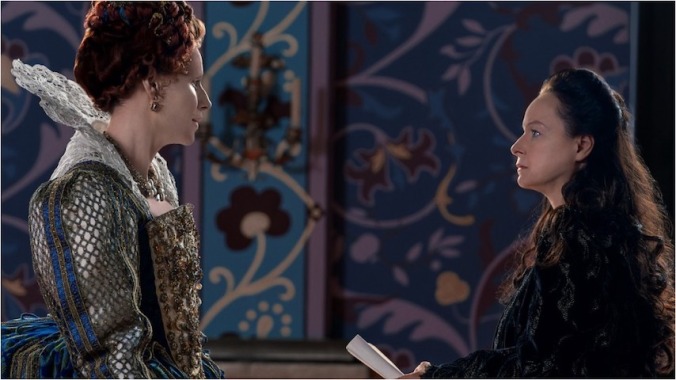How The Serpent Queen Season 2 Explores the Performative Facades of Powerful Women
Samantha Morton and Minnie Driver talk playing two complicated historical women, the masks they wear, and the truth that's likely somewhere in between
Photo Courtesy of Starz

Starz drama The Serpent Queen follows the story of one of history’s most influential women: Catherine de Medici. But the version of her that history often prefers to remember—a witch, a murderess, a lover of poisons and dark magic—likely bears little resemblance to the woman she actually was. And she’s hardly an outlier in that regard when it comes to famous historical women. After all, more people probably remember England’s Elizabeth I for the simple act of not getting married than for most of the things she did.
In many ways, it makes sense that the Starz drama, with its boundary-pushing ideas about female power and ambition, would bring these two women together. True, the real Catherine and Elizabeth most likely never actually met in real life, but The Serpent Queen is a show that understands sometimes good drama requires a bit of creative license when it comes to messy things like the truth. Cast as both a foil and a mirror for Catherine, this version of Elizabeth Tudor also carefully crafts an image for the benefit of those around her, playing the role of the ditzy, virginal flirt as determinedly as Catherine allows her reputation as a treacherous bitch to flourish. They’re not only wildly entertaining to watch together, but their scenes offer a compelling exploration of the way powerful women throughout history have been asked to perform for the male gaze.
“The thing that was brilliant [about their interactions] was what Justin [Haythe, series writer and showrunner] wrote was so specific that you had very clear directives for both these women,” Minnie Driver, who plays Queen Elizabeth, tells Paste when asked about how she and Morton approached creating a historical interaction that probably never happened. “Catherine very much wanted an alliance with Britain and she could leverage her son, and she had a spare in case the first one didn’t work out. Elizabeth was on a fact-finding mission to find out how Catherine de’ Medici was running France, [and] what was really going on. So she leveraged her virginity and her hand in marriage to come on a fact-finding mission.”
“To me, it was about exploring this idea of the business side of things, [between them],” Samantha Morton, who plays Catherine, adds. “It’s a game of chess and you’re not going to win every game, but you can learn from your opponent. And she’s looking at this other amazing businesswoman going, ‘Oh my gosh, she’s phenomenal!’”
According to Driver, working with Morton had a similar flavor of two experienced women coming together and recognizing each other’s abilities.
“You have these two women with very specific objectives coming together, and in a way, I always felt like that’s really what we did [in our performances],” Driver says. “Sam and I both knew exactly why we were there. And the minute you’re clear about where you’re beginning and where it’s going to end up, you can just play in the middle. And because we’ve both been doing this for such a long time, you’re playing at quite a high degree of difficulty, which is really fun when you’ve been doing it for 30 years. We had a very intense, fun time doing this because we both knew what we were doing.”
Onscreen, there’s also a certain level of mutual respect between Morton’s Catherine and Driver’s Elizabeth. Neither of the two women appears to particularly like the other, but it’s easy to see how much they have in common as female rulers in a man’s world.
“I didn’t play it too much about rivalry or about disliking this woman,” Morton says. “It’s more like she’s running her business and I’m running mine. And what’s brilliant about the show, is that in the first season, you see Catherine strive to be good at the business. And then in Season 2, it’s all falling apart at the seams.”
The penultimate episode of The Serpent Queen’s second season sees Elizabeth finally head back to England, having dismissed offers to marry both of Catherine’s sons and abandoned the trade agreement the Medici queen was so desperate to negotiate. But before she dramatically exits stage left, Elizabeth and Catherine finally have the sort of brutal heart-to-heart most viewers had likely been hoping to see for weeks. Masks off between one another for the first time, Elizabeth owns up to the false face she often presents to the public and correctly observes that Catherine herself does the same.
“They did what they did as men, unapologetic in their appetites,” Elizabeth tells her rival, speaking of the exploits of her wife-killing father, King Henry VIII, and the wandering eye of Catherine’s father-in-law Francis I. “You and I don’t have such luxuries. So, yes, I must pose as a virgin and you as a witch to get what we want.”
-

-

-

-

-

- Curated Home Page Articles By Test Admin October 21, 2025 | 3:10pm
-

- Curated Home Page Articles By Test Admin October 21, 2025 | 2:57pm
- Urls By Test Admin October 21, 2025 | 2:57pm
- Curated Home Page Articles By Test Admin October 21, 2025 | 2:55pm
-

-

-

-

-

-

-

-

-

-

-

-

-

-

-

-

-

-

-

-

-

-

-

-

-

-

-

-

-

-




































